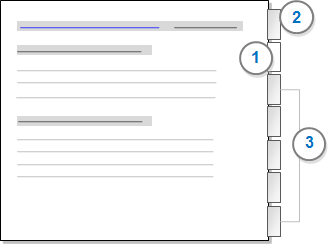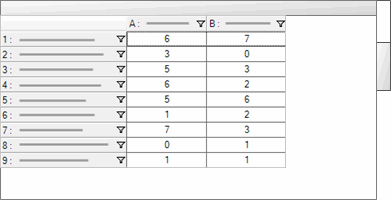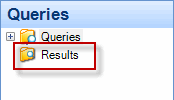Manage query results
When you run a query, by default the results are displayed as a preview in Detail View. You may review the results and then discard them or (for some types of queries) you may want to store the results in your project.
What do you want to do?
- Preview your results
- Save a query visualization as a picture
- Make a node from Text Search, Coding or Compound query results
- Make a node matrix from Matrix Coding query results
- Understand the Results folder
- View the query that generated a results node (or node matrix)
- Copy a results node (or node matrix) to the Nodes folder
- Delete a results node or node matrix
Preview your results
When you run a query, by default, the results are displayed in Detail View as a preview.
You can explore and interact with the results of a query when it is displayed as a preview. For example, you might run a Text Search query to find all references to the word balance. When the results are displayed in Detail View you can explore the references and click on the Word Tree tab to understand the contexts in which the word appears.
After you have explored the results in Detail View, you can decide whether or not you want to save them. You may have no need to save the results—if you do not save them, they are discarded when you close the Detail View window.
Most queries provide visualizations of the data (for example, word clouds and tree maps). You may want to save only the visualizations and then discard the query results—refer to Save a query visualization as a picture for more information.
The preview results of some queries can be converted into project items and stored in your project, for more information, refer to:
You cannot store the results of Word Frequency queries, Coding Comparison queries or Group queries.
If you want to share your results with others or work with them in another application, you can export the results of queries from the preview in Detail View—refer to Export query results for more information.
Save a query visualization as a picture
Many queries provide ways to visualize the results—for example, Word Frequency query results can be viewed as a word cloud.
If you are keeping a project journal and using it to record your ideas and analysis, you might want to copy the visualization and paste it into your journal
To copy and paste a query visualization into a memo or document within your project:
-
Click in the visualization.
-
On the Home tab, in the Clipboard group, click Copy (CTRL+C).

-
Click in location that you want to paste the image within your memo or document. Make sure the memo or document is open in Edit Mode.
-
On the Home tab, in the Clipboard group, click Paste (CTRL+V).
NOTE
-
You can save a query visualization as a picture source, by pasting the copied image into a source folder in List View.
-
You can export query visualizations and include them in reports or PowerPoint presentations—refer to Export query results for more information.
Make a node from Text Search, Coding or Compound query results
The preview result of a Text Search query, Coding query or Compound query is a temporary node, which you can optionally save into your project.

1 Just like a node, there is a Reference tab, which contains the source content that was returned by the query.
2 The Summary tab lists the sources that contain the content.
3 There are tabs for each type of source content that was found—for example, text, audio or video content.
You can store the results as a new node in your project (or merge them into an existing node). By default, the new node is created in the Results folder. Refer to Understand the Results folder for more information.
Refer to the following topics for detailed information:
Make a node matrix from Matrix Coding query results
The preview results of a Matrix Coding query is a temporary node matrix.

You can store the results as a new node matrix in your project. By default, the new node matrix is created in the Results folder. You can move it into your Nodes folder later, if necessary. Refer to Understand the Results folder for more information.
Refer to Run a Matrix Coding query for detailed information.
Understand the Results folder
When you save query results as a node or node matrix, the default location is the Results folder—a good place to keep result nodes until you decide that you want to add them to your node hierarchy.

If you delete or update project items that are included in saved query results—the results are updated to reflect the changes. If you add new items that match the query criteria they are not automatically included in the results. To make sure that your query results accurately reflect the current state of your project, it is best to run the query again.
When the node or node matrix is in the Results folder, you can view the query that generated the results.
You cannot change the content coded to a node when it is in the Results folder, because it represents the results of the query at the time you ran it. You can open the node and review the references. You can select content in the node to annotate, link or 'code-on' to other nodes. However, if you want to code additional content to the node, spread coding to surrounding content, or uncode some of the references, you will need to copy the node into your Nodes folder.
You can copy a node from the Results folder to your Nodes folder at any time—once it is in your Nodes folder you can work with it in the same way that you work with any other node. If you delete (or move) the node from the Results folder, you will not be able to view the query that generated it.
Likewise you can copy a node matrix from your Results folder to your Node Matrices folder at any time. If you delete (or move) the node matrix from the Results folder, you will not be able to view the query that generated it.
View the query that generated a results node (or node matrix)
The results of Text Search, Coding, Compound and Matrix Coding queries can be stored in the Results folder as result nodes or node matrices.
To view the query that generated a result node or node matrix:
-
In Navigation View, click the Results folder and then select the results node (or node matrix) in List View.
-
On the Home tab, in the Item group, click the arrow under Open and select Open Linked Query.

The Query Properties dialog box opens
NOTE You can only view the query—you cannot change it or run it, because it represents the query that was used to create the result. If you added the query to the project when you created it, the query will also be in your Queries folder and you can run it again.
Copy a results node (or node matrix) to the Nodes folder
When you store nodes in the Results folder, their content is fixed—it is a snapshot representing the results of the query at the time you ran it. This means you cannot code additional content to the node or uncode any references that you decide are not relevant. You can copy the node into your Nodes folder at any time, if you want to bring it into your node hierarchy and be able to code and uncode node references.
To copy a results node (or node matrix) to the Nodes folder
-
In the List View, select the results node or node matrix.
-
On the Home tab, in the Clipboard group, click Copy (CTRL+C).

-
In Navigation View, click the Nodes folder (or Node Matrices folder) where you want to paste the copied result.
-
On the Home tab, in the Clipboard group, click Paste (CTRL+V).
-
Click Yes to confirm.
NOTE If you delete (or move) the node from the Results folder, you will not be able to view the query that generated it.
Delete a results node or node matrix
If you no longer need a result node or node matrix, you can delete it from the Results folder.
To delete a results node or node matrix:
-
In Navigation View, click the Results folder and then select the node in List View.
-
On the Home tab, in the Editing group, click Delete.



